stop start FIAT IDEA 2012 1.G User Guide
[x] Cancel search | Manufacturer: FIAT, Model Year: 2012, Model line: IDEA, Model: FIAT IDEA 2012 1.GPages: 210, PDF Size: 3.65 MB
Page 126 of 210
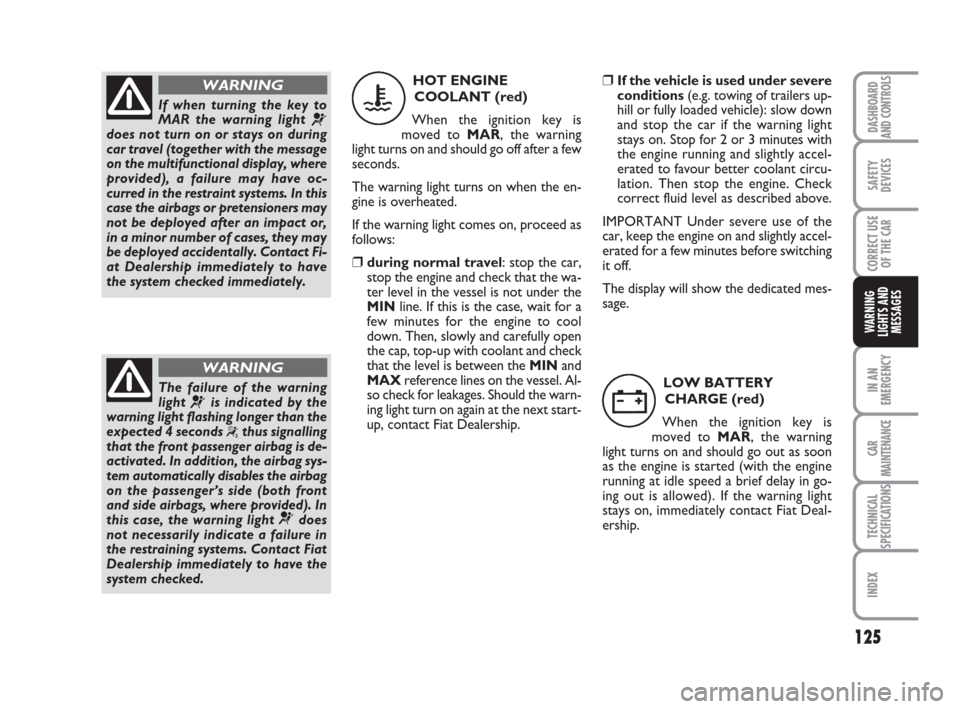
125
IN AN
EMERGENCY
CAR
MAINTENANCE
TECHNICAL
SPECIFICATIONS
INDEX
DASHBOARD
AND CONTROLS
SAFETY
DEVICES
CORRECT USE
OF THE CAR
WARNING
LIGHTS AND
MESSAGES
If when turning the key to
MAR the warning light
¬does not turn on or stays on during
car travel (together with the message
on the multifunctional display, where
provided), a failure may have oc-
curred in the restraint systems. In this
case the airbags or pretensioners may
not be deployed after an impact or,
in a minor number of cases, they may
be deployed accidentally. Contact Fi-
at Dealership immediately to have
the system checked immediately.
WARNING
The failure of the warning
light
¬is indicated by the
warning light flashing longer than the
expected 4 seconds
“thus signalling
that the front passenger airbag is de-
activated. In addition, the airbag sys-
tem automatically disables the airbag
on the passenger’s side (both front
and side airbags, where provided). In
this case, the warning light
¬does
not necessarily indicate a failure in
the restraining systems. Contact Fiat
Dealership immediately to have the
system checked.
WARNING
HOT ENGINE
COOLANT (red)
When the ignition key is
moved to MAR, the warning
light turns on and should go off after a few
seconds.
The warning light turns on when the en-
gine is overheated.
If the warning light comes on, proceed as
follows:
❒during normal travel: stop the car,
stop the engine and check that the wa-
ter level in the vessel is not under the
MINline. If this is the case, wait for a
few minutes for the engine to cool
down. Then, slowly and carefully open
the cap, top-up with coolant and check
that the level is between the MINand
MAXreference lines on the vessel. Al-
so check for leakages. Should the warn-
ing light turn on again at the next start-
up, contact Fiat Dealership.
u
❒If the vehicle is used under severe
conditions(e.g. towing of trailers up-
hill or fully loaded vehicle): slow down
and stop the car if the warning light
stays on. Stop for 2 or 3 minutes with
the engine running and slightly accel-
erated to favour better coolant circu-
lation. Then stop the engine. Check
correct fluid level as described above.
IMPORTANT Under severe use of the
car, keep the engine on and slightly accel-
erated for a few minutes before switching
it off.
The display will show the dedicated mes-
sage.
LOW BATTERY
CHARGE (red)
When the ignition key is
moved to MAR, the warning
light turns on and should go out as soon
as the engine is started (with the engine
running at idle speed a brief delay in go-
ing out is allowed). If the warning light
stays on, immediately contact Fiat Deal-
ership.
w
123-132 idea GB 1 ed 10-07-2008 8:29 Pagina 125
Page 127 of 210
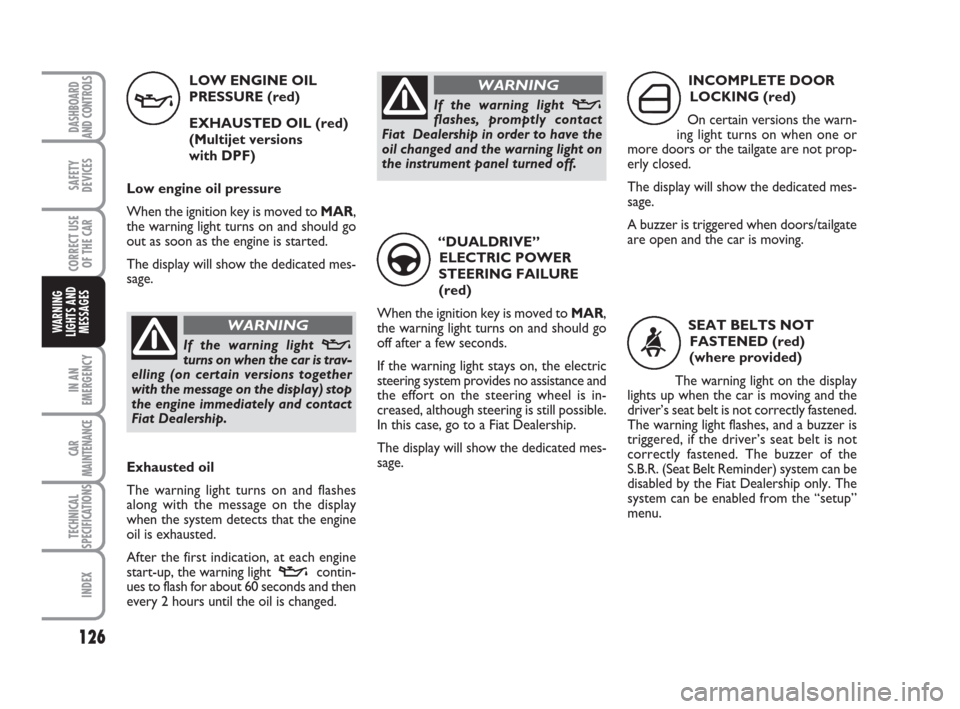
126
IN AN
EMERGENCY
CAR
MAINTENANCE
TECHNICAL
SPECIFICATIONS
INDEX
DASHBOARD
AND CONTROLS
SAFETY
DEVICES
CORRECT USE
OF THE CAR
WARNING
LIGHTS AND
MESSAGES
LOW ENGINE OIL
PRESSURE (red)
EXHAUSTED OIL (red)
(Multijet versions
with DPF)
Low engine oil pressure
When the ignition key is moved to MAR,
the warning light turns on and should go
out as soon as the engine is started.
The display will show the dedicated mes-
sage.
v
Exhausted oil
The warning light turns on and flashes
along with the message on the display
when the system detects that the engine
oil is exhausted.
After the first indication, at each engine
start-up, the warning light
vcontin-
ues to flash for about 60 seconds and then
every 2 hours until the oil is changed.“DUALDRIVE”
ELECTRIC POWER
STEERING FAILURE
(red)
When the ignition key is moved to MAR,
the warning light turns on and should go
off after a few seconds.
If the warning light stays on, the electric
steering system provides no assistance and
the effort on the steering wheel is in-
creased, although steering is still possible.
In this case, go to a Fiat Dealership.
The display will show the dedicated mes-
sage.
g
INCOMPLETE DOOR
LOCKING (red)
On certain versions the warn-
ing light turns on when one or
more doors or the tailgate are not prop-
erly closed.
The display will show the dedicated mes-
sage.
A buzzer is triggered when doors/tailgate
are open and the car is moving.
´
SEAT BELTS NOT
FASTENED (red)
(where provided)
The warning light on the display
lights up when the car is moving and the
driver’s seat belt is not correctly fastened.
The warning light flashes, and a buzzer is
triggered, if the driver’s seat belt is not
correctly fastened. The buzzer of the
S.B.R. (Seat Belt Reminder) system can be
disabled by the Fiat Dealership only. The
system can be enabled from the “setup”
menu.
with the message on the display) stop
the engine immediately and contact
Fiat Dealership.
WARNING
If the warning light vflashes, promptly contact
Fiat Dealership in order to have the
oil changed and the warning light on
the instrument panel turned off.
WARNING
123-132 idea GB 1 ed 10-07-2008 8:29 Pagina 126
Page 128 of 210
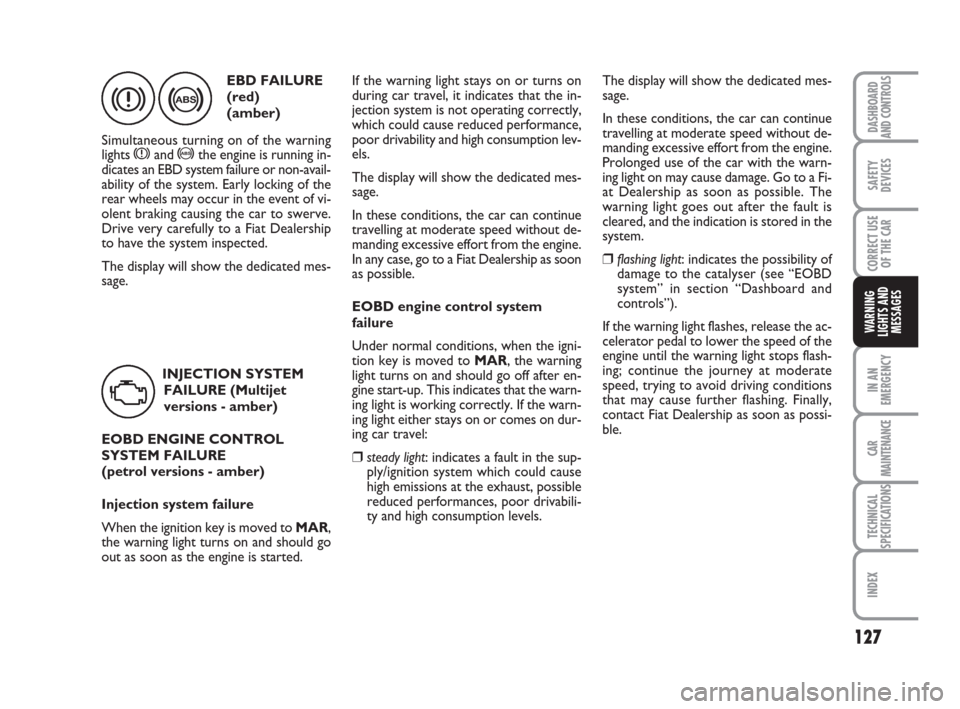
127
IN AN
EMERGENCY
CAR
MAINTENANCE
TECHNICAL
SPECIFICATIONS
INDEX
DASHBOARD
AND CONTROLS
SAFETY
DEVICES
CORRECT USE
OF THE CAR
WARNING
LIGHTS AND
MESSAGES
>
EBD FAILURE
(red)
(amber)
Simultaneous turning on of the warning
lights
xand >the engine is running in-
dicates an EBD system failure or non-avail-
ability of the system. Early locking of the
rear wheels may occur in the event of vi-
olent braking causing the car to swerve.
Drive very carefully to a Fiat Dealership
to have the system inspected.
The display will show the dedicated mes-
sage.
x
INJECTION SYSTEM
FAILURE (Multijet
versions - amber)
EOBD ENGINE CONTROL
SYSTEM FAILURE
(petrol versions - amber)
Injection system failure
When the ignition key is moved to MAR,
the warning light turns on and should go
out as soon as the engine is started.If the warning light stays on or turns on
during car travel, it indicates that the in-
jection system is not operating correctly,
which could cause reduced performance,
poor drivability and high consumption lev-
els.
The display will show the dedicated mes-
sage.
In these conditions, the car can continue
travelling at moderate speed without de-
manding excessive effort from the engine.
In any case, go to a Fiat Dealership as soon
as possible.
EOBD engine control system
failure
Under normal conditions, when the igni-
tion key is moved to MAR, the warning
light turns on and should go off after en-
gine start-up. This indicates that the warn-
ing light is working correctly. If the warn-
ing light either stays on or comes on dur-
ing car travel:
❒steady light: indicates a fault in the sup-
ply/ignition system which could cause
high emissions at the exhaust, possible
reduced performances, poor drivabili-
ty and high consumption levels.
U
The display will show the dedicated mes-
sage.
In these conditions, the car can continue
travelling at moderate speed without de-
manding excessive effort from the engine.
Prolonged use of the car with the warn-
ing light on may cause damage. Go to a Fi-
at Dealership as soon as possible. The
warning light goes out after the fault is
cleared, and the indication is stored in the
system.
❒flashing light: indicates the possibility of
damage to the catalyser (see “EOBD
system” in section “Dashboard and
controls”).
If the warning light flashes, release the ac-
celerator pedal to lower the speed of the
engine until the warning light stops flash-
ing; continue the journey at moderate
speed, trying to avoid driving conditions
that may cause further flashing. Finally,
contact Fiat Dealership as soon as possi-
ble.
123-132 idea GB 1 ed 10-07-2008 8:29 Pagina 127
Page 130 of 210
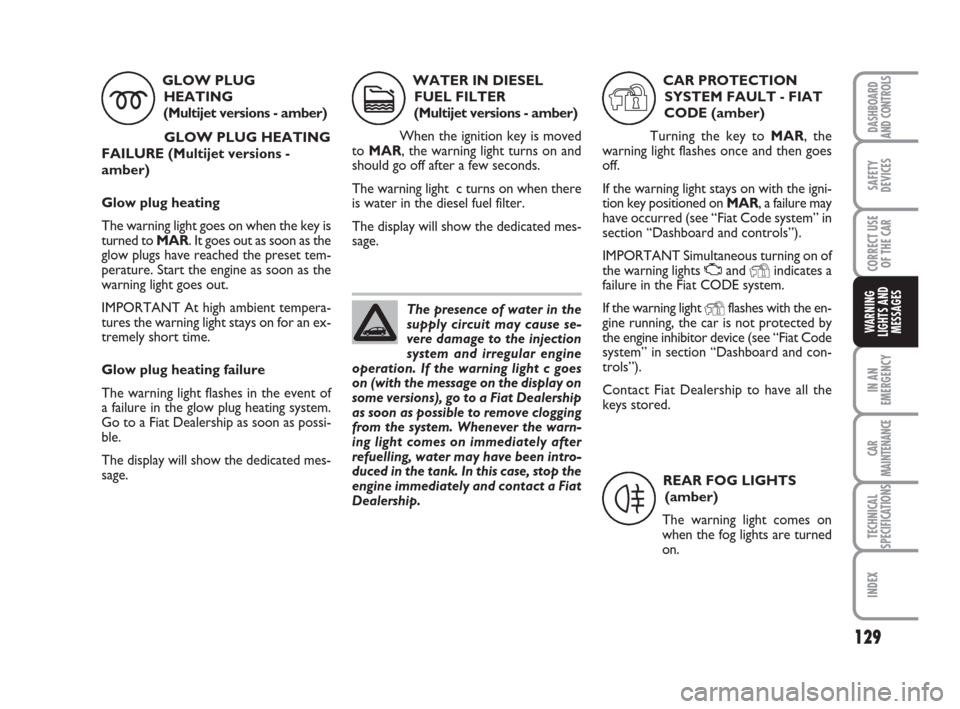
129
IN AN
EMERGENCY
CAR
MAINTENANCE
TECHNICAL
SPECIFICATIONS
INDEX
DASHBOARD
AND CONTROLS
SAFETY
DEVICES
CORRECT USE
OF THE CAR
WARNING
LIGHTS AND
MESSAGES
GLOW PLUG
HEATING
(Multijet versions - amber)
GLOW PLUG HEATING
FAILURE (Multijet versions -
amber)
Glow plug heating
The warning light goes on when the key is
turned to MAR. It goes out as soon as the
glow plugs have reached the preset tem-
perature. Start the engine as soon as the
warning light goes out.
IMPORTANT At high ambient tempera-
tures the warning light stays on for an ex-
tremely short time.
Glow plug heating failure
The warning light flashes in the event of
a failure in the glow plug heating system.
Go to a Fiat Dealership as soon as possi-
ble.
The display will show the dedicated mes-
sage.
m
WATER IN DIESEL
FUEL FILTER
(Multijet versions - amber)
When the ignition key is moved
to MAR, the warning light turns on and
should go off after a few seconds.
The warning light c turns on when there
is water in the diesel fuel filter.
The display will show the dedicated mes-
sage.
c
CAR PROTECTION
SYSTEM FAULT - FIAT
CODE (amber)
Turning the key to MAR, the
warning light flashes once and then goes
off.
If the warning light stays on with the igni-
tion key positioned on MAR, a failure may
have occurred (see “Fiat Code system” in
section “Dashboard and controls”).
IMPORTANT Simultaneous turning on of
the warning lights
Uand Yindicates a
failure in the Fiat CODE system.
If the warning light
Yflashes with the en-
gine running, the car is not protected by
the engine inhibitor device (see “Fiat Code
system” in section “Dashboard and con-
trols”).
Contact Fiat Dealership to have all the
keys stored.
Y
REAR FOG LIGHTS
(amber)
The warning light comes on
when the fog lights are turned
on.
4
The presence of water in the
supply circuit may cause se-
vere damage to the injection
system and irregular engine
operation. If the warning light c goes
on (with the message on the display on
some versions), go to a Fiat Dealership
as soon as possible to remove clogging
from the system. Whenever the warn-
ing light comes on immediately after
refuelling, water may have been intro-
duced in the tank. In this case, stop the
engine immediately and contact a Fiat
Dealership.
123-132 idea GB 1 ed 10-07-2008 8:29 Pagina 129
Page 136 of 210
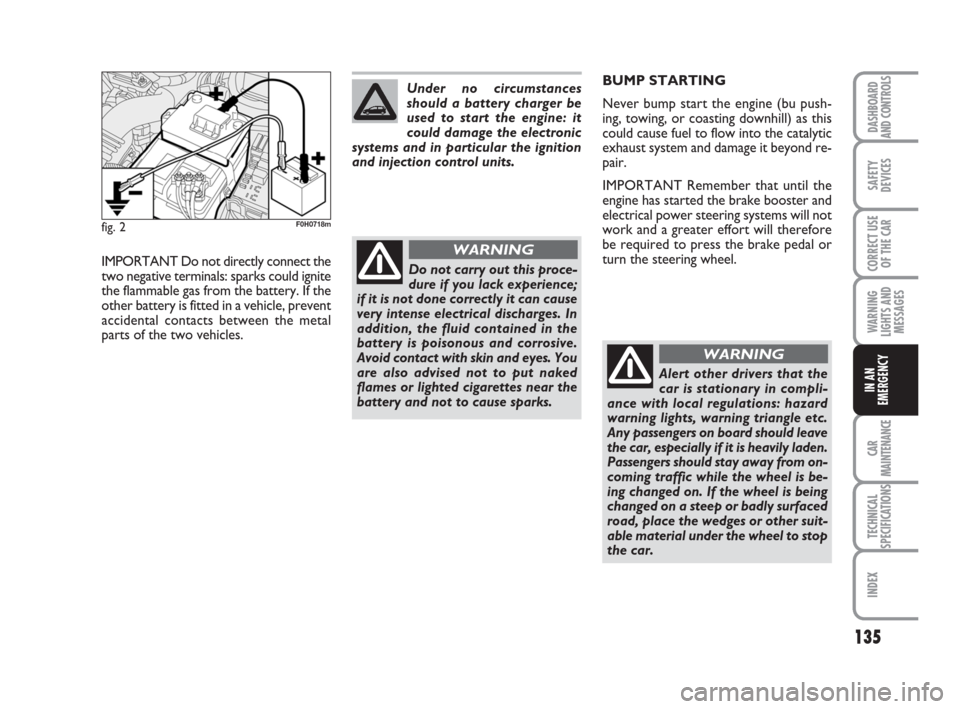
135
CAR
MAINTENANCE
TECHNICAL
SPECIFICATIONS
INDEX
DASHBOARD
AND CONTROLS
SAFETY
DEVICES
CORRECT USE
OF THE CAR
WARNING
LIGHTS AND
MESSAGES
IN AN
EMERGENCY
fig. 2F0H0718m
IMPORTANT Do not directly connect the
two negative terminals: sparks could ignite
the flammable gas from the battery. If the
other battery is fitted in a vehicle, prevent
accidental contacts between the metal
parts of the two vehicles.Do not carry out this proce-
dure if you lack experience;
if it is not done correctly it can cause
very intense electrical discharges. In
addition, the fluid contained in the
battery is poisonous and corrosive.
Avoid contact with skin and eyes. You
are also advised not to put naked
flames or lighted cigarettes near the
battery and not to cause sparks.
WARNING
Under no circumstances
should a battery charger be
used to start the engine: it
could damage the electronic
systems and in particular the ignition
and injection control units.BUMP STARTING
Never bump start the engine (bu push-
ing, towing, or coasting downhill) as this
could cause fuel to flow into the catalytic
exhaust system and damage it beyond re-
pair.
IMPORTANT Remember that until the
engine has started the brake booster and
electrical power steering systems will not
work and a greater effort will therefore
be required to press the brake pedal or
turn the steering wheel.
Alert other drivers that the
car is stationary in compli-
ance with local regulations: hazard
warning lights, warning triangle etc.
Any passengers on board should leave
the car, especially if it is heavily laden.
Passengers should stay away from on-
coming traffic while the wheel is be-
ing changed on. If the wheel is being
changed on a steep or badly surfaced
road, place the wedges or other suit-
able material under the wheel to stop
the car.
WARNING
133-160 idea GB 1 ed 10-07-2008 8:30 Pagina 135
Page 139 of 210
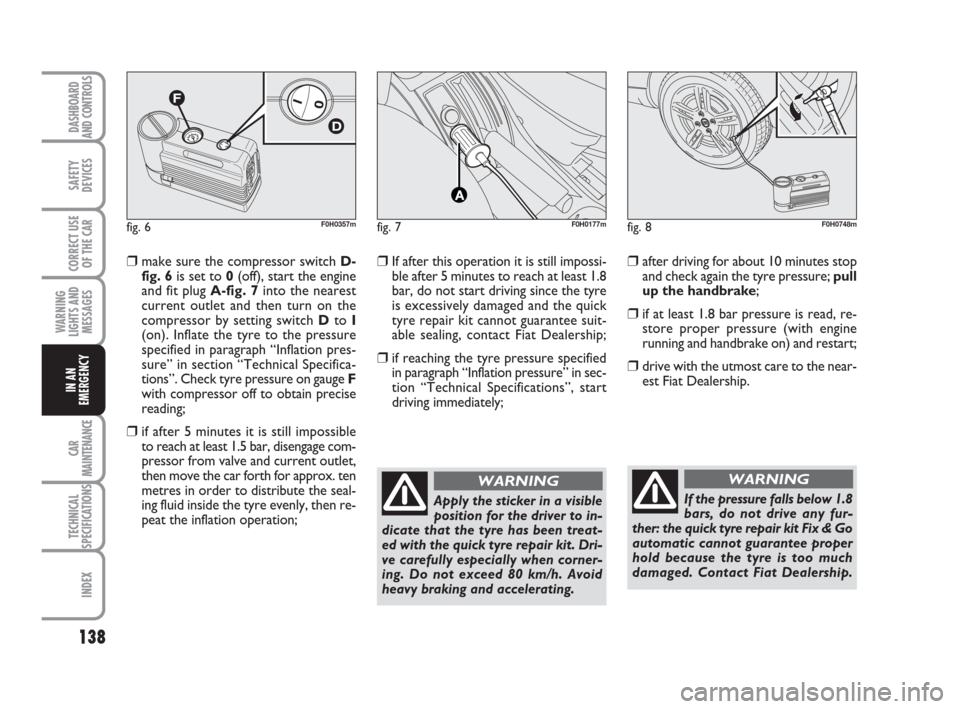
138
CAR
MAINTENANCE
TECHNICAL
SPECIFICATIONS
INDEX
DASHBOARD
AND CONTROLS
SAFETY
DEVICES
CORRECT USE
OF THE CAR
WARNING
LIGHTS AND
MESSAGES
IN AN
EMERGENCY
fig. 6F0H0357mfig. 7F0H0177mfig. 8F0H0748m
❒make sure the compressor switch D-
fig. 6is set to 0(off), start the engine
and fit plug A-fig. 7into the nearest
current outlet and then turn on the
compressor by setting switch Dto I
(on). Inflate the tyre to the pressure
specified in paragraph “Inflation pres-
sure” in section “Technical Specifica-
tions”. Check tyre pressure on gauge F
with compressor off to obtain precise
reading;
❒if after 5 minutes it is still impossible
to reach at least 1.5 bar, disengage com-
pressor from valve and current outlet,
then move the car forth for approx. ten
metres in order to distribute the seal-
ing fluid inside the tyre evenly, then re-
peat the inflation operation;
❒If after this operation it is still impossi-
ble after 5 minutes to reach at least 1.8
bar, do not start driving since the tyre
is excessively damaged and the quick
tyre repair kit cannot guarantee suit-
able sealing, contact Fiat Dealership;
❒if reaching the tyre pressure specified
in paragraph “Inflation pressure” in sec-
tion “Technical Specifications”, start
driving immediately;
Apply the sticker in a visible
position for the driver to in-
dicate that the tyre has been treat-
ed with the quick tyre repair kit. Dri-
ve carefully especially when corner-
ing. Do not exceed 80 km/h. Avoid
heavy braking and accelerating.
WARNING
If the pressure falls below 1.8
bars, do not drive any fur-
ther: the quick tyre repair kit Fix & Go
automatic cannot guarantee proper
hold because the tyre is too much
damaged. Contact Fiat Dealership.
WARNING
❒after driving for about 10 minutes stop
and check again the tyre pressure; pull
up the handbrake;
❒if at least 1.8 bar pressure is read, re-
store proper pressure (with engine
running and handbrake on) and restart;
❒drive with the utmost care to the near-
est Fiat Dealership.
133-160 idea GB 1 ed 10-07-2008 8:30 Pagina 138
Page 161 of 210
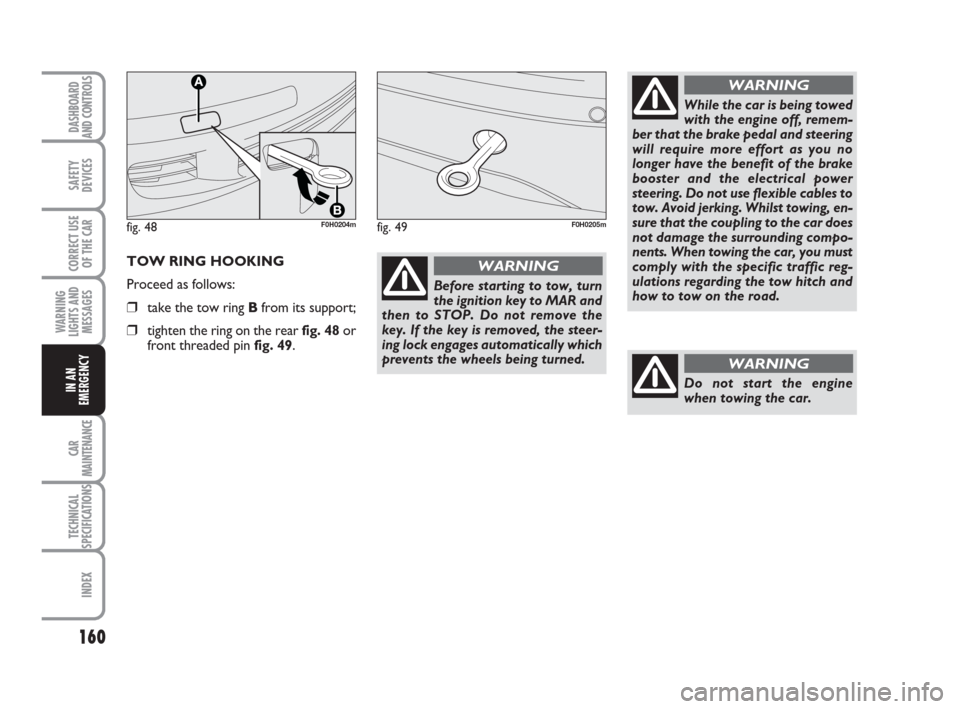
160
CAR
MAINTENANCE
TECHNICAL
SPECIFICATIONS
INDEX
DASHBOARD
AND CONTROLS
SAFETY
DEVICES
CORRECT USE
OF THE CAR
WARNING
LIGHTS AND
MESSAGES
IN AN
EMERGENCY
TOW RING HOOKING
Proceed as follows:
❒take the tow ring Bfrom its support;
❒tighten the ring on the rear fig. 48 or
front threaded pin fig. 49.
fig. 48F0H0204mfig. 49F0H0205m
Before starting to tow, turn
the ignition key to MAR and
then to STOP. Do not remove the
key. If the key is removed, the steer-
ing lock engages automatically which
prevents the wheels being turned.
WARNING
While the car is being towed
with the engine off, remem-
ber that the brake pedal and steering
will require more effort as you no
longer have the benefit of the brake
booster and the electrical power
steering. Do not use flexible cables to
tow. Avoid jerking. Whilst towing, en-
sure that the coupling to the car does
not damage the surrounding compo-
nents. When towing the car, you must
comply with the specific traffic reg-
ulations regarding the tow hitch and
how to tow on the road.
WARNING
Do not start the engine
when towing the car.
WARNING
133-160 idea GB 1 ed 10-07-2008 8:30 Pagina 160
Page 176 of 210
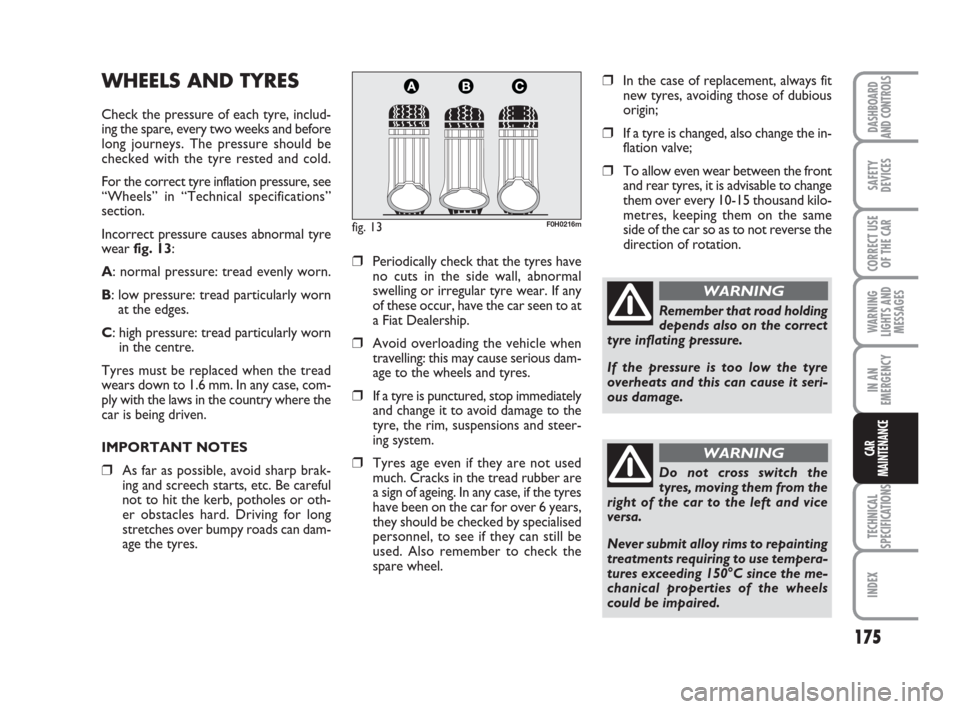
175
TECHNICAL
SPECIFICATIONS
INDEX
DASHBOARD
AND CONTROLS
SAFETY
DEVICES
CORRECT USE
OF THE CAR
WARNING
LIGHTS AND
MESSAGES
IN AN
EMERGENCY
CAR
MAINTENANCE
WHEELS AND TYRES
Check the pressure of each tyre, includ-
ing the spare, every two weeks and before
long journeys. The pressure should be
checked with the tyre rested and cold.
For the correct tyre inflation pressure, see
“Wheels” in “Technical specifications”
section.
Incorrect pressure causes abnormal tyre
wear fig. 13:
A: normal pressure: tread evenly worn.
B: low pressure: tread particularly worn
at the edges.
C: high pressure: tread particularly worn
in the centre.
Tyres must be replaced when the tread
wears down to 1.6 mm. In any case, com-
ply with the laws in the country where the
car is being driven.
IMPORTANT NOTES
❒As far as possible, avoid sharp brak-
ing and screech starts, etc. Be careful
not to hit the kerb, potholes or oth-
er obstacles hard. Driving for long
stretches over bumpy roads can dam-
age the tyres.
❒Periodically check that the tyres have
no cuts in the side wall, abnormal
swelling or irregular tyre wear. If any
of these occur, have the car seen to at
a Fiat Dealership.
❒Avoid overloading the vehicle when
travelling: this may cause serious dam-
age to the wheels and tyres.
❒If a tyre is punctured, stop immediately
and change it to avoid damage to the
tyre, the rim, suspensions and steer-
ing system.
❒Tyres age even if they are not used
much. Cracks in the tread rubber are
a sign of ageing. In any case, if the tyres
have been on the car for over 6 years,
they should be checked by specialised
personnel, to see if they can still be
used. Also remember to check the
spare wheel.
fig. 13F0H0216m
Remember that road holding
depends also on the correct
tyre inflating pressure.
If the pressure is too low the tyre
overheats and this can cause it seri-
ous damage.
WARNING
Do not cross switch the
tyres, moving them from the
right of the car to the left and vice
versa.
Never submit alloy rims to repainting
treatments requiring to use tempera-
tures exceeding 150°C since the me-
chanical properties of the wheels
could be impaired.
WARNING
❒In the case of replacement, always fit
new tyres, avoiding those of dubious
origin;
❒If a tyre is changed, also change the in-
flation valve;
❒To allow even wear between the front
and rear tyres, it is advisable to change
them over every 10-15 thousand kilo-
metres, keeping them on the same
side of the car so as to not reverse the
direction of rotation.
161-180 idea GB 1 ed 10-07-2008 8:30 Pagina 175
Page 204 of 210
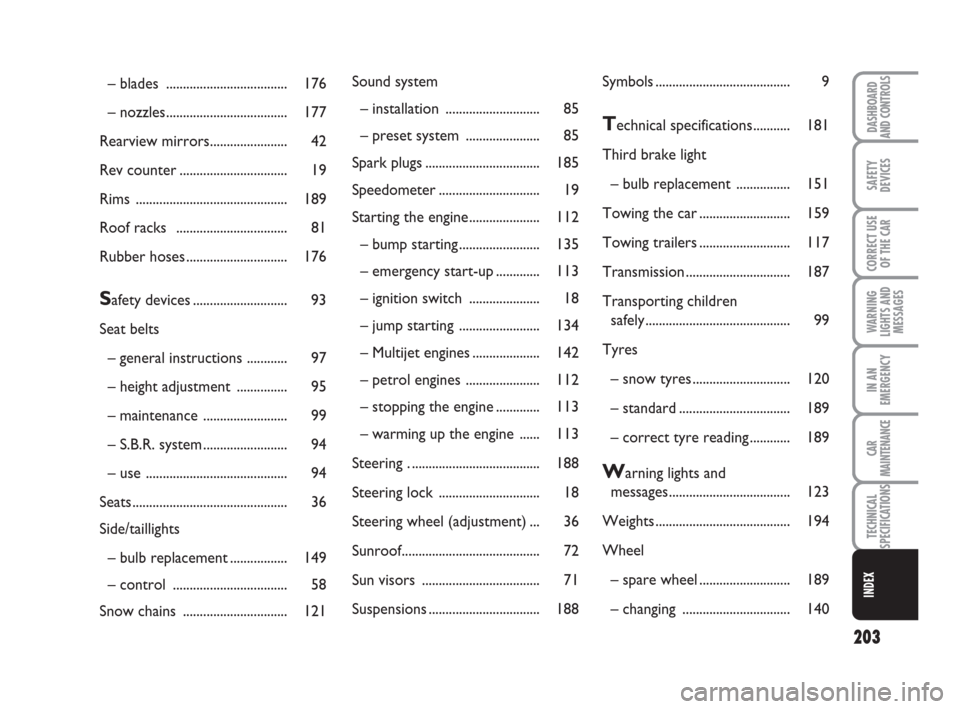
203
SAFETY
DEVICES
CORRECT USE
OF THE CAR
WARNING
LIGHTS AND
MESSAGES
IN AN
EMERGENCY
CAR
MAINTENANCE
TECHNICAL
SPECIFICATIONS
DASHBOARD
AND CONTROLS
INDEX
– blades .................................... 176
– nozzles.................................... 177
Rearview mirrors....................... 42
Rev counter ................................ 19
Rims ............................................. 189
Roof racks ................................. 81
Rubber hoses .............................. 176
Safety devices ............................ 93
Seat belts
– general instructions ............ 97
– height adjustment ............... 95
– maintenance ......................... 99
– S.B.R. system ......................... 94
– use .......................................... 94
Seats .............................................. 36
Side/taillights
– bulb replacement ................. 149
– control .................................. 58
Snow chains ............................... 121Symbols ........................................ 9
Technical specifications........... 181
Third brake light
– bulb replacement ................ 151
Towing the car ........................... 159
Towing trailers ........................... 117
Transmission ............................... 187
Transporting children
safely ........................................... 99
Tyres
– snow tyres ............................. 120
– standard ................................. 189
– correct tyre reading ............ 189
Warning lights and
messages.................................... 123
Weights ........................................ 194
Wheel
– spare wheel ........................... 189
– changing ................................ 140 Sound system
– installation ............................ 85
– preset system ...................... 85
Spark plugs .................................. 185
Speedometer .............................. 19
Starting the engine..................... 112
– bump starting ........................ 135
– emergency start-up ............. 113
– ignition switch ..................... 18
– jump starting ........................ 134
– Multijet engines .................... 142
– petrol engines ...................... 112
– stopping the engine ............. 113
– warming up the engine ...... 113
Steering . ...................................... 188
Steering lock .............................. 18
Steering wheel (adjustment) ... 36
Sunroof......................................... 72
Sun visors ................................... 71
Suspensions ................................. 188
200-208 idea GB 1 ed 10-07-2008 10:58 Pagina 203